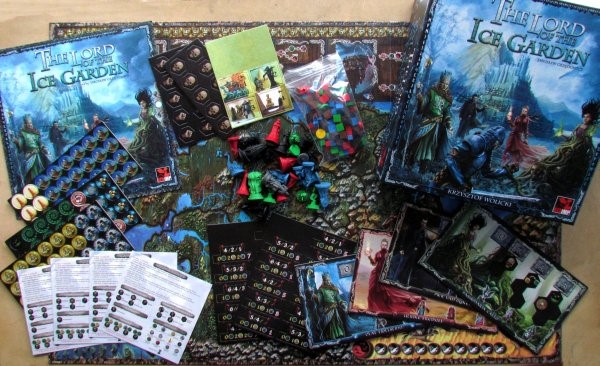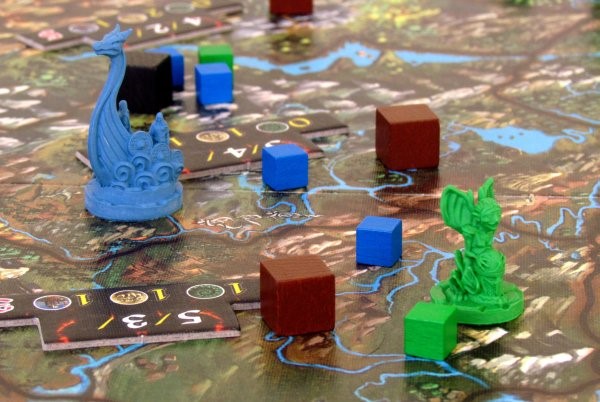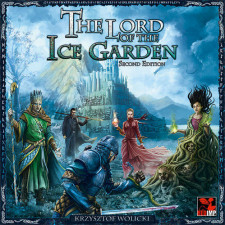Lord of the Ice Garden (Second Edition) Review
on Sep 7, 2016
Based on a Polish fantasy novel, Krzysztof Wolicki’s The Lord of the Ice Garden makes a great impression with nice illustrations, better-than-expected resin miniatures, and a tremendous effort to communicate the narrative of its source material. The story is a compelling starting point for a game- it’s original, fresh and pretty cool. Earth scientists are dispatched to a distant planet, Midgaard, where the dominant culture somewhat resembles Northern Europe in the Dark Ages. The scientists discover an energy dubbed M-Factor, and decide to stay…and use the energy (which is essentially magic for the Midgaardians) to take the place over. But Earth has also sent an agent to track down and return the scientists who’ve gone native.

The novel has never been translated into English, so you kind of just get a high-level overview of the back story. And it gets a little complicated, because each of the four rogue scientists- this is you, players- has a completely different narrative motivation, method for winning, and three unique units each with their own raison d’etre. So when you do the pre-game rules brief with your gang, be prepared to spend some time explaining what the Voracious Mountain is and why the Dead Snow signals the end of the game. Imagine playing a Lord of the Rings game with very little understanding of the larger story, and that’s kind of what it’s like.
But with that lack of familiarity comes a degree of exoticism that is truly alluring. This is a world of Ice Drakkars and Moonlit Brothers, where the Lady of Sorrow is trying to lock regions in her nightmares and the Lord of the People of the Snake conducts M-Factor fueled experiments with making crab people in an amorphous energy-absorbing tower called The Thorn. You got all that?
When it comes to the gameplay, The Lord of the Ice Garden comes across as a descendent of El Grande by way of Chaos in the Old World, which situates it in proximity to other recent titles such as Blood Rage and Cthulhu Wars. Fans of any or all of the above area control/Dudes on a Map hybrids might find this game to be worth a look, but it is a soft recommendation because it simply isn’t as cleanly designed. It’s a fairly complicated game that feels somewhat overwrought- but its original concepts nudge it toward a positive notice.
Outside of the subject matter it feels mostly familiar if you have experience with its antecedents. There is a sort of weird initiative phase where the turn order gets sorted each round, and players have to move their markers one or two spaces along a track which also indicates a supply of action markers for the round. It’s the same concept as the turn order cards in El Grande- the sooner you go, the less you get. The initiative phase is also where the scoring rounds are triggered, when someone moves up to designated spaces. Following that, you then you go into a planning phase where you place those action markers, worker placement-style, on slots that will resolve in the Action phase. Actions are the usual assortment of moving, building, buying and upgrading things with three currencies in the mix (Population, Gold and M-Factor). After all actions are accounted for, any units players have on the board activate.
Each unique unit upgrades individually, increasing primarily its speed, attack, defense or dominance and some have special ability upgrades. Combat is a matter of paying two gold and then pooling your total attack values and seeing what shakes down between units and influence markers- and fighting does give VPs, so there is an incentive beyond taking control of an area. In the subsequent Domination phase, everyone standing in a region tallies up their total influence (along with any special abilities that might be going off) and points are awarded. And then character-specific effects occur, which typically connect to the goals of the scientists. Finally, everyone in a region gets a choice of available resources as indicated on the region’s scoring tile.

It’s all definitely on the higher end of the complexity scale of these kinds of games if only because there are so many different things going on – and this is without playing the advanced game, which adds the Vuko Drakkinen character, special events connected to him, and the ability to change the order of actions during the Action Phase. There is also this Dead Snow track that moves when players create new units and a metric that impacts players with bad reputations. And then there are “independent nation†markers that go into the Domination mix. It’s also on the longer side of the spectrum- expect at least 30-40 minutes per player, so 2 ½ hours plus for a full complement of four power-hungry scientists. There’s also a decent two player option and a solo game, which is one of the things that sets this one apart from the rest, but it is area control- so it’s best with three or four.
It’s a neat game with a great sense of setting that comes across without reams of card text. For all of its mechanical complications, it’s well-made and there aren’t really any superfluous elements, except maybe that entire worker placement subsystem in the action phase which I think should have been cut in favor of action points or a simpler method of selection. Regardless of my taste, there’s plenty of competition, lots of dynamics to consider, and it looks great on the table so it is not without its own merits or charms. The number one problem with it, and one that make be terminal for many audiences, is that it is hard to make a case for the game against something sleeker like Blood Rage or more time-tested like Chaos in the Old World.

 Customer Support
Customer Support  Subscribe
Subscribe 




 Account
Account  Wishlist
Wishlist 

